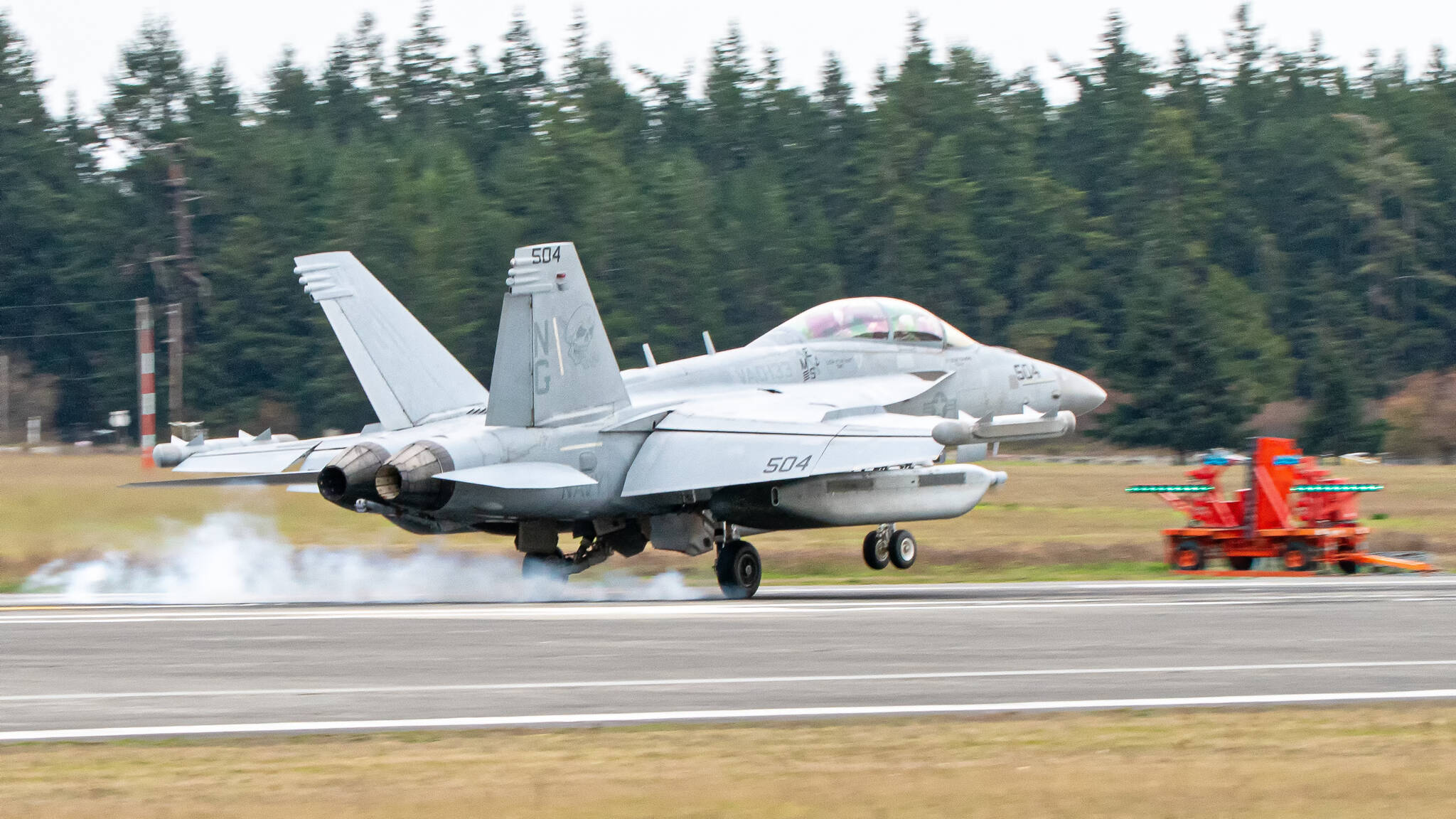A federal magistrate judge ruled in favor of the state Attorney General’s Office and a Whidbey anti-noise group on several critical issues in a lawsuit over EA-18G Growler aircraft stationed at Naval Air Station Whidbey Island.
On Friday, Chief United States Magistrate Judge J. Richard Creatura filed his report and recommendation, which will go to Judge Richard Jones for a final decision. The parties have 14 days to file written objections.
It’s unclear what the consequences will be if the judge follows the recommendations. If the Navy has to redo portions of the Environmental Impact Statement, the big question is whether Growler operations at Outlying Field Coupeville will be reduced while the work is going on. Creatura asked the parties to submit stipulations as to remedies within 30 days of the final ruling.
In 2019, Attorney General Bob Ferguson and Citizens of Ebey’s Reserve filed separate lawsuits, which were later joined into one, in U.S. District Court in Seattle. They argued that the Navy violated the National Environmental Policy Act, or NEPA, and other federal laws by not adequately analyzing the impacts an increased number of the Navy aircraft would have on the environment and the community.
Creatura did not pull any punches in his report, writing that the Navy selected methods of evaluating data that supported its goal of bringing more Growlers to NAS Whidbey.
“The Navy did this at the expense of the public and the environment, turning a blind eye to data that would not support this intended result,” he wrote. “Or, to borrow the words of noted sports analyst Vin Scully, the Navy appears to have used certain statistics ‘much like a drunk uses a lamppost: for support, not illumination.’”
Attorney General Bob Ferguson sent the Whidbey News-Times a comment about the decision Friday night.
“The Navy has an important job, and it’s critical that their pilots and crews have the opportunity to train,” he wrote. “That does not relieve the federal government of its obligation to follow the law and take a hard look at any harm to child learning and natural resources. Today the magistrate judge recognized that the Navy fell far short of its obligation.”
Specifically, Creatura found that the Navy violated NEPA by failing to disclose the basis for greenhouse gas emission calculations; failing to quantify the impact of increased operations on classroom learning; failing to take a hard look at species-specific impacts on birds; and failing to give detailed consideration to the idea of moving some operations to the base in El Centro, California.
“With respect to the impact of this increased operation on childhood learning,” Creatura wrote, “the Navy acknowledged numerous studies that concluded that aircraft noise would measurably impact learning but then arbitrarily concluded that because it could not quantify exactly how the increased operations would interfere with childhood learning, no further analysis was necessary.”
All other claims against the Navy were dismissed, which included arguments that the Navy also violated the Administrative Procedure Act and the National Historic Preservation Act. Under NEPA, the Navy’s final decision may only be overturned if the Navy acted “arbitrarily and capriciously” and failed to take a “hard look” at the consequences of the proposed action.
Creatura seemed receptive, for example, to COER’s argument that the Navy’s noise calculation that averages loud days with quiet ones doesn’t fairly represent reality, but he wrote that he is constrained in ruling because “the Navy did not arbitrarily or capriciously choose the annual average metric.”
Still, Creatura was critical of the Navy throughout his report.
“One would think that with a nearly 200,000-page record, it would not be hard to convince a court that the Navy took a ‘hard look’ at the impacts on people and the environment,” he wrote. “However, the value of the record is not in its breadth but in its ability to inform the Navy’s decision. In this, unfortunately, the record is lacking.”
Predictably, the magistrate judge’s report and recommendation had mixed responses on Whidbey, where the issue of jet noise has sometimes divided the community.
COER President Bob Wilbur said they represent an important step forward in the group’s longtime struggle against Growler noise.
“Military jets, while necessary for America’s defense, should never have been based in civilian communities in the first place,” he said. “This problem has been obvious but ignored for a long time. Now that this court has spoken so clearly, it’s time for our congressional leaders to step in and find a solution.”
Steve Bristow with the Oak Harbor Navy League said the magistrate judge’s report is flawed, including new interpretations of NEPA and at least a couple contradictory recommendations. If adopted, the report and recommendation would cause harm to both the Navy’s mission and the Whidbey community, he said in an email.
“Growler expansion versus activist litigation is not an all-else-equal calculus,” Bristow wrote. “Business environment, prosperity, property values, tax bases, law enforcement and first responders, Island County health care capability, educational levies and more are now at tangible, long-term risk.”
COER attorney David Bricklin suggested during a hearing in federal court that the parties should meet to see if they can agree on a remedy that would allow pilot training while protecting the community. Bristow, however, was skeptical, especially with the activist’s “hard-line” position “on drastically reducing practice or moving the Growlers elsewhere.”
Under the Navy’s record of decision in 2019, which followed a lengthy environmental study process, NAS Whidbey received 36 new Growler aircraft and was directed to conduct 80% of the field carrier landing practice at OLF Coupeville. Growler landing practice “passes” at the small Central Whidbey airfield were allowed to increase from about 3,000 a year to more than 12,000.



